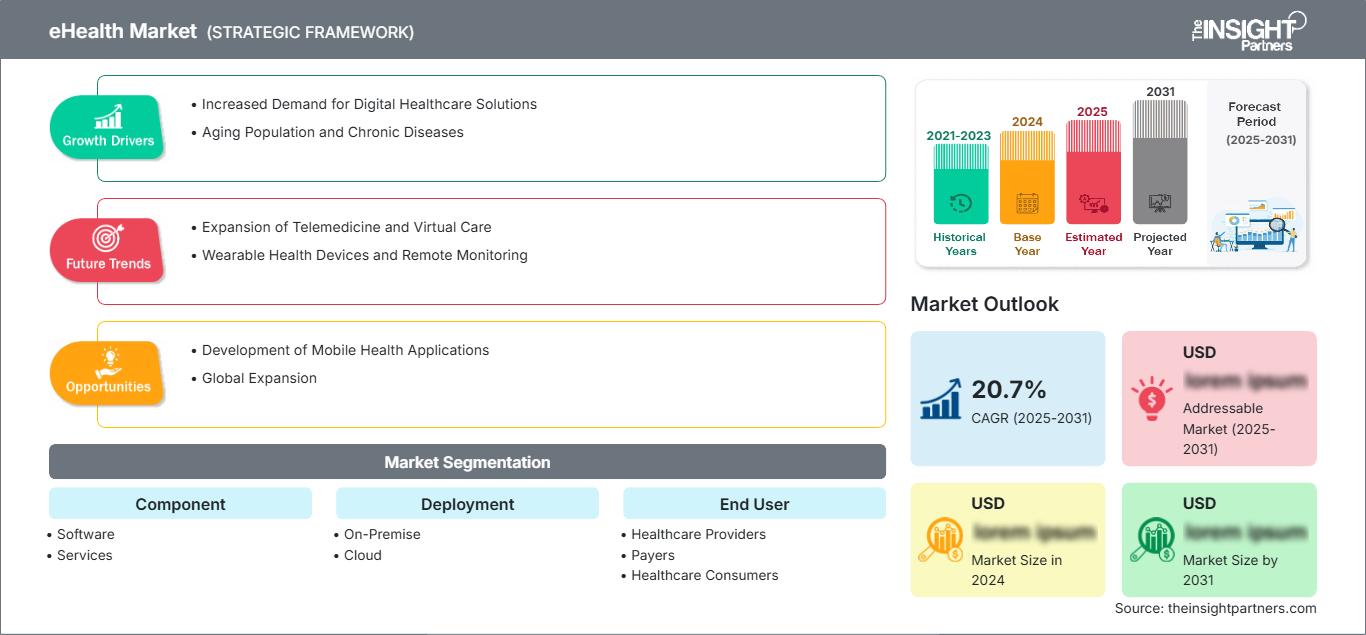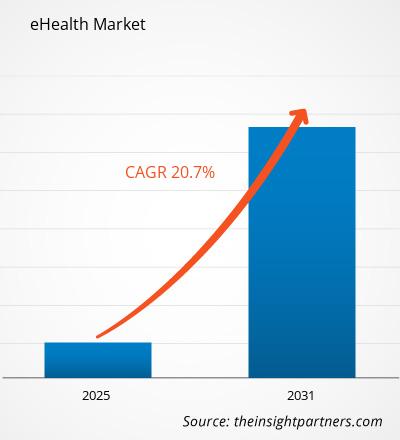Se prevé que el mercado de la salud electrónica registre una tasa de crecimiento anual compuesta (TCAC) del 20,7% entre 2025 y 2031, con un tamaño de mercado que se expandirá de XX millones de dólares estadounidenses en 2024 a XX millones de dólares estadounidenses en 2031.
El informe se segmenta por componente {Software (Registros Electrónicos de Salud, Receta Electrónica, Sistemas de Apoyo a la Decisión Clínica, Telemedicina y otros componentes), Servicios}; Implementación (Local, Nube) y Usuario final (Proveedores de atención médica, Aseguradoras, Pacientes y Otros). El análisis global se desglosa aún más a nivel regional y por países principales. El informe ofrece el valor en USD para el análisis y los segmentos mencionados.
Finalidad del informe
El informe sobre el mercado de la salud digital, elaborado por The Insight Partners, tiene como objetivo describir el panorama actual y el crecimiento futuro, los principales factores impulsores, los desafíos y las oportunidades. Esto proporcionará información valiosa a diversos actores del sector, tales como:
- Proveedores/fabricantes de tecnología: Para comprender la evolución de la dinámica del mercado y conocer las posibles oportunidades de crecimiento, lo que les permitirá tomar decisiones estratégicas informadas.
- Inversores: Realizar un análisis exhaustivo de las tendencias relativas a la tasa de crecimiento del mercado, las proyecciones financieras del mercado y las oportunidades que existen a lo largo de la cadena de valor.
- Organismos reguladores: Regular las políticas y controlar las actividades en el mercado con el objetivo de minimizar los abusos, preservar la confianza de los inversores y mantener la integridad y la estabilidad del mercado.
Segmentación del mercado de la salud digital
Componente
- Software
- Servicios
Despliegue
- En las instalaciones
- Nube
Usuario final
- Proveedores de atención médica
- Pagadores
- Consumidores de atención médica
Geografía
- América del norte
- Europa
- Asia Pacífico
- Oriente Medio y África
- América del Sur y Central
Obtendrá personalización gratuita de cualquier informe, incluyendo partes de este informe, análisis a nivel de país y paquetes de datos de Excel. Además, podrá aprovechar excelentes ofertas y descuentos para empresas emergentes y universidades.
Mercado de la salud digital: Perspectivas estratégicas

- Obtenga las principales tendencias clave del mercado que se describen en este informe.Esta muestra GRATUITA incluirá análisis de datos, que abarcarán desde tendencias de mercado hasta estimaciones y pronósticos.
Factores que impulsan el crecimiento del mercado de la salud digital
- Mayor demanda de soluciones digitales para la salud: La demanda de soluciones digitales para la salud ha aumentado debido a que la atención médica se ha vuelto más centrada en el paciente y basada en datos. Las tecnologías de salud digital se están adoptando cada vez más en los países como un medio para mejorar la experiencia del paciente.
- Envejecimiento de la población y enfermedades crónicas: Con el aumento de la esperanza de vida mundial, muchas personas mayores padecen enfermedades crónicas. Este cambio demográfico exige soluciones sanitarias más eficientes, que la salud digital puede proporcionar.
Tendencias futuras del mercado de la salud digital
- Expansión de la telemedicina y la atención virtual: La adopción de la telemedicina y los servicios de salud virtual está a punto de crecer significativamente, impulsada por los avances en las tecnologías de comunicación digital y la creciente demanda de atención médica conveniente y accesible. En el futuro, las plataformas de telesalud se integrarán más con otras soluciones de salud digital, lo que permitirá consultas fluidas, monitoreo remoto y acceso a profesionales de la salud de diversas especialidades. Los chatbots con inteligencia artificial, los diagnósticos remotos y los asistentes virtuales de salud mejorarán aún más la experiencia del paciente, brindando atención personalizada y reduciendo la presión sobre los sistemas de salud tradicionales. La telemedicina también se extenderá a los servicios de salud mental, rehabilitación y manejo de enfermedades crónicas, lo que permitirá que más personas accedan a la atención médica desde la comodidad de sus hogares.
- Dispositivos portátiles de salud y monitorización remota: El uso de dispositivos portátiles y herramientas de monitorización remota seguirá en aumento, permitiendo el seguimiento continuo de parámetros vitales de salud como la frecuencia cardíaca, la presión arterial, los niveles de glucosa y los patrones de sueño. Estos dispositivos se integrarán cada vez más con plataformas en la nube, lo que permitirá a los profesionales sanitarios monitorizar de forma remota los datos de los pacientes en tiempo real e intervenir cuando sea necesario.
Oportunidades de mercado en el sector de la salud digital
- Desarrollo de aplicaciones móviles de salud: El segmento de aplicaciones médicas es uno de los que más contribuyen al mercado de la salud digital, lo que indica una importante oportunidad para que los desarrolladores creen aplicaciones innovadoras de gestión de la salud.
- Expansión global: A medida que más países reconocen los beneficios de la salud digital, existen grandes oportunidades para la expansión del mercado, particularmente en las regiones en desarrollo donde el acceso a la atención médica es limitado.
Perspectivas regionales del mercado de la salud digital
Los analistas de The Insight Partners han explicado en detalle las tendencias y los factores regionales que influyen en el mercado de la salud digital durante el período de previsión. Esta sección también analiza los segmentos del mercado de la salud digital y su distribución geográfica en Norteamérica, Europa, Asia Pacífico, Oriente Medio y África, y Sudamérica y Centroamérica.
Alcance del informe de mercado de la salud digital
| Atributo del informe | Detalles |
|---|---|
| Tamaño del mercado en 2024 | XX millones de dólares estadounidenses |
| Tamaño del mercado para 2031 | XX millones de dólares estadounidenses |
| Tasa de crecimiento anual compuesto global (2025 - 2031) | 20,7% |
| Datos históricos | 2021-2023 |
| período de previsión | 2025-2031 |
| Segmentos cubiertos | Por componente
|
| Regiones y países cubiertos | América del norte
|
| Líderes del mercado y perfiles de empresas clave |
|
Densidad de los actores del mercado de la salud digital: comprensión de su impacto en la dinámica empresarial
El mercado de la salud digital está creciendo rápidamente, impulsado por la creciente demanda de los usuarios finales debido a factores como la evolución de las preferencias de los consumidores, los avances tecnológicos y una mayor conciencia de los beneficios del producto. A medida que aumenta la demanda, las empresas amplían su oferta, innovan para satisfacer las necesidades de los consumidores y aprovechan las tendencias emergentes, lo que impulsa aún más el crecimiento del mercado.

- Obtenga una visión general de los principales actores del mercado de la salud digital.
Puntos clave de venta
- Cobertura integral: El informe abarca de forma exhaustiva el análisis de productos, servicios, tipos y usuarios finales del mercado de la salud digital, proporcionando una visión holística.
- Análisis de expertos: El informe se elabora a partir del profundo conocimiento de expertos y analistas del sector.
- Información actualizada: El informe garantiza su relevancia para el negocio gracias a su cobertura de información reciente y tendencias de datos.
- Opciones de personalización: Este informe se puede personalizar para satisfacer las necesidades específicas del cliente y adaptarse adecuadamente a las estrategias comerciales.
Por lo tanto, el informe de investigación sobre el mercado de la salud digital puede ayudar a impulsar la comprensión del panorama del sector y sus perspectivas de crecimiento. Si bien existen algunas preocupaciones válidas, los beneficios generales de este informe tienden a superar las desventajas.
- Análisis histórico (2 años), año base, pronóstico (7 años) con CAGR
- Análisis PEST y FODA
- Tamaño del mercado, valor/volumen: global, regional y nacional
- Industria y panorama competitivo
- Conjunto de datos de Excel
Informes recientes
Testimonios
Razón para comprar
- Toma de decisiones informada
- Comprensión de la dinámica del mercado
- Análisis competitivo
- Información sobre clientes
- Pronósticos del mercado
- Mitigación de riesgos
- Planificación estratégica
- Justificación de la inversión
- Identificación de mercados emergentes
- Mejora de las estrategias de marketing
- Impulso de la eficiencia operativa
- Alineación con las tendencias regulatorias




















 Obtenga una muestra gratuita para - Mercado de eSalud
Obtenga una muestra gratuita para - Mercado de eSalud